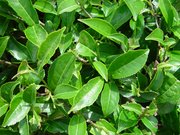Camellia sinensis
|
|
| Camellia sinensis - Tea | ||||||||||||||
|---|---|---|---|---|---|---|---|---|---|---|---|---|---|---|
 Camellia sinensis foliage | ||||||||||||||
| Scientific classification | ||||||||||||||
|
Camellia sinensis is the tea plant, the plant species whose leaves and leaf buds are used to produce tea. The name sinensis means "Chinese" in Latin. Older names for the tea plant include Thea bohea and Thea viridis.
Camellia sinensis is native to Southeast Asia, but is today cultivated across the world, in tropical and subtropical regions. It is an evergreen shrub or small tree that is usually trimmed to below two metres (six feet) when cultivated for its leaves. It has a strong taproot. The flowers are yellow-white, 2.5-4 cm in diameter, with 7 to 8 petals. The seeds can be pressed to yield an oil.
Green, oolong and black tea are all harvested from this species, but are processed to attain different levels of oxidation.
Tea_plant_drawing.png
The leaves are 4-15 cm long and 2-5 cm broad. Fresh leaves contain about 4% caffeine. The young, light green leaves are preferably harvested for tea production; they have short white hairs on the underside. Older leaves are darker green. Different leaf ages produce differing tea qualities, since their chemical compositions are different. Usually, the tip (bud) and the first two to three leaves are harvested for processing. This hand picking is repeated every one to two weeks.
Several varieties of C. sinensis are used for tea production:
- Assam variety
- The most volume comes from the Assam variety (sometimes called C. sinensis var. assamica or C. assamica). It is a small tree (single stemmed) with large leaves. In the wild it reaches a height of 6 to 20 meters (20-65 feet); in tea estates it is kept trimmed to just above waist level. A lowland plant, it requires a high rainfall but good drainage. It does not tolerate extreme temperatures. Discovered in 1823 (though used earlier by local people in their brews), it is one of the two original tea plants. All Assam teas and most Ceylon teas are from this plant. The Assam plant produces malty, earthy drinks, unlike the generally flowery yield of the China plant.
- China variety
- The Chinese plant (sometimes called C. sinensis var. sinensis) is a small-leaved bush with multiple stems that reaches a height of some 3 meters. The first tea plant to be discovered, recorded and used to produce tea three thousand years ago, it yields some of the most popular teas.
- Cambodian variety
- The Cambodian plant is sometimes called C. sinensis var. parvifolia. Its leaves are in size between the Assam and Chinese varieties; it is a small tree with several stems. It is sometimes referred to as a hybrid of the Assam and China plants.
See also
- Tea tree oil is derived from Melaleuca alternifolia which is native to Australia and unrelated to the tea plant discussed here.
- Tea tree is a name sometimes applied to a number of different plants unrelated to the tea plant.
External links
- Camellia sinensis (http://www.hort.purdue.edu/newcrop/duke_energy/Camellia_sinensis.html) from Purdue University
- Camellia sinensis Classification (http://www.tocklai.org/about_tea/tea_class.htm) from Toklai Tea Research Station, Jorhat, Assam.da:Tebusk (Camellia sinensis)
es:Camellia sinensis he:קמיליה סיננסיס pt:Camellia sinensis fi:Teepensas zh:茶树
